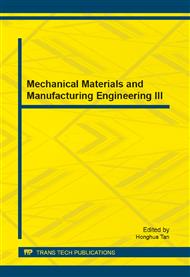p.54
p.60
p.66
p.71
p.77
p.83
p.88
p.94
p.99
Synthesis of the Gold-Supported Chitosan-Modified Nanomaterials and Effect of Preparation Conditions
Abstract:
In the present work, a new composite gold-supported chitosan-silica (Au/CS-SiO2) nanomaterial has been synthesized via organic modification and chemical reduction method. Firstly, the hybrid chitosan-silica (CS-SiO2) material was synthesized by modification of silica with chitosan under suitable reaction conditions. Furthermore, based on the ligand effect of chitosan molecule and the reduction ability of organic alcohols and ascorbic acid, gold nanoparticles were generated and fixed on the surface of hybrid CS-SiO2 material, which successfully leading to production of the composite Au/CS-SiO2 nanomaterial. The obtained samples were characterized by the infrared spectroscopy, X-ray diffraction and transmission electron microscopy. Moreover, thermogravimetric analysis was also used to examine their thermal stabilities. It was found that the reducing agent is closely related to the size, shape and amount of gold nanoparticles, and the modification of chitosan decides the stability of the material. These materials can exhibit promising application as the catalyst in chemical field.
Info:
Periodical:
Pages:
77-82
Citation:
Online since:
November 2013
Authors:
Keywords:
Price:
Сopyright:
© 2014 Trans Tech Publications Ltd. All Rights Reserved
Share:
Citation:


